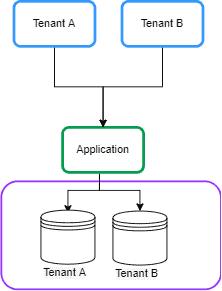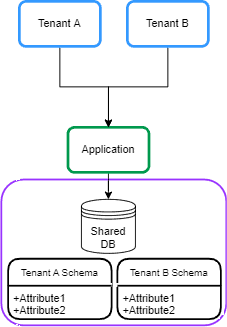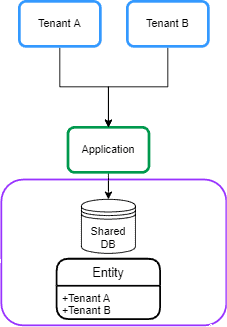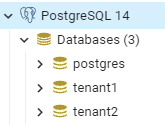1. 概述
多租户指的是一种架构,其中软件应用程序的单个实例为多个租户或客户提供服务。
它在租户之间实现所需程度的隔离,以便租户使用的数据和资源与其他数据和资源分开。
在本教程中,我们将了解如何使用 Spring Data JPA 在Spring Boot应用程序中配置多租户。此外,我们使用JWT为租户增加安全性。
2. 多租户模型
多租户系统主要有以下三种方法:
- 独立的数据库
- 共享数据库和独立模式
- 共享数据库和共享模式
2.1. 独立的数据库
在这种方法中,每个租户的数据都保存在一个单独的数据库实例中,并与其他租户隔离。这也称为每个租户的数据库:
2.2. 共享数据库和独立模式
在这种方法中,每个租户的数据都保存在共享数据库上的不同模式中。这有时称为每个租户的模式:
2.3. 共享数据库和共享模式
在这种方法中,所有租户共享一个数据库,每个表都有一个包含租户标识符的列:
3.Maven依赖
让我们首先在pom.xml的Spring Boot应用程序中声明spring-boot-starter-data-jpa依赖项:
<dependency>
<groupId>org.springframework.boot</groupId>
<artifactId>spring-boot-starter-data-jpa</artifactId>
</dependency>
此外,我们将使用PostgreSQL数据库,因此我们还要将postgresql依赖项添加到pom.xml文件中:
<dependency>
<groupId>org.postgresql</groupId>
<artifactId>postgresql</artifactId>
<scope>runtime</scope>
</dependency>
分离数据库和共享数据库以及分离模式方法在Spring Boot应用程序中的配置相似。在本教程中,我们重点介绍分离数据库方法。
4.动态数据源路由
在本节中,我们将描述Database per Tenant模型背后的一般思想。
4.1. 抽象路由数据源
使用 Spring Data JPA 实现多租户的总体思路是在运行时根据当前租户标识符路由数据源。
为此,我们可以使用AbstractRoutingDatasource作为一种根据当前租户动态确定实际数据源的方法。
让我们创建一个扩展AbstractRoutingDataSource类的MultitenantDataSource 类:
public class MultitenantDataSource extends AbstractRoutingDataSource {
@Override
protected String determineCurrentLookupKey() {
return TenantContext.getCurrentTenant();
}
}
AbstractRoutingDataSource将getConnection调用路由到基于查找键的各种目标数据源之一。
查找键通常是通过一些线程绑定的事务上下文来确定的。因此,我们创建了一个TenantContext 类来存储每个请求中的当前租户:
public class TenantContext {
private static final ThreadLocal<String> CURRENT_TENANT = new ThreadLocal<>();
public static String getCurrentTenant() {
return CURRENT_TENANT.get();
}
public static void setCurrentTenant(String tenant) {
CURRENT_TENANT.set(tenant);
}
}
我们使用ThreadLocal对象来保存当前请求的租户 ID。此外,我们使用set方法存储租户 ID,并使用get()方法检索它。
4.2. 为每个请求设置租户 ID
在这个配置设置之后,当我们执行任何租户操作时,我们需要在创建任何交易之前知道租户 ID。因此,我们需要在访问控制器端点之前在过滤器 或拦截器中设置租户 ID。
让我们添加一个TenantFilter 来设置TenantContext中的当前租户:
@Component
@Order(1)
class TenantFilter implements Filter {
@Override
public void doFilter(ServletRequest request, ServletResponse response,
FilterChain chain) throws IOException, ServletException {
HttpServletRequest req = (HttpServletRequest) request;
String tenantName = req.getHeader("X-TenantID");
TenantContext.setCurrentTenant(tenantName);
try {
chain.doFilter(request, response);
} finally {
TenantContext.setCurrentTenant("");
}
}
}
在此过滤器中,我们从请求标头X-TenantID 中获取租户 ID,并将其设置在TenantContext中。我们将控制传递给过滤器链。我们的 finally块确保在下一个请求之前重置当前租户。这避免了任何跨租户请求污染的风险。
在下一节中,我们将在 Database per Tenant模型中实现租户和数据源声明。
5.数据库方法
在本节中,我们将基于每个租户模型的数据库实施多租户。
5.1. 租户声明
在这种方法中,我们有多个数据库,因此我们需要在Spring Boot应用程序中声明多个数据源。
我们可以在单独的租户文件中配置数据源。因此,我们在allTenants目录下创建tenant_1.properties 文件并声明租户的数据源:
name=tenant_1
datasource.url=jdbc:postgresql://localhost:5432/tenant1
datasource.username=postgres
datasource.password=123456
datasource.driver-class-name=org.postgresql.Driver
此外,我们为另一个租户创建一个tenant_2.properties文件:
name=tenant_2
datasource.url=jdbc:postgresql://localhost:5432/tenant2
datasource.username=postgres
datasource.password=123456
datasource.driver-class-name=org.postgresql.Driver
我们最终将为每个租户创建一个文件:
5.2. 数据源声明
现在我们需要读取租户的数据并使用DataSourceBuilder类创建DataSource。此外,我们在AbstractRoutingDataSource类中设置DataSources 。
让我们为此添加一个MultitenantConfiguration类:
@Configuration
public class MultitenantConfiguration {
@Value("${defaultTenant}")
private String defaultTenant;
@Bean
@ConfigurationProperties(prefix = "tenants")
public DataSource dataSource() {
File[] files = Paths.get("allTenants").toFile().listFiles();
Map<Object, Object> resolvedDataSources = new HashMap<>();
for (File propertyFile : files) {
Properties tenantProperties = new Properties();
DataSourceBuilder dataSourceBuilder = DataSourceBuilder.create();
try {
tenantProperties.load(new FileInputStream(propertyFile));
String tenantId = tenantProperties.getProperty("name");
dataSourceBuilder.driverClassName(tenantProperties.getProperty("datasource.driver-class-name"));
dataSourceBuilder.username(tenantProperties.getProperty("datasource.username"));
dataSourceBuilder.password(tenantProperties.getProperty("datasource.password"));
dataSourceBuilder.url(tenantProperties.getProperty("datasource.url"));
resolvedDataSources.put(tenantId, dataSourceBuilder.build());
} catch (IOException exp) {
throw new RuntimeException("Problem in tenant datasource:" + exp);
}
}
AbstractRoutingDataSource dataSource = new MultitenantDataSource();
dataSource.setDefaultTargetDataSource(resolvedDataSources.get(defaultTenant));
dataSource.setTargetDataSources(resolvedDataSources);
dataSource.afterPropertiesSet();
return dataSource;
}
}
首先,我们从allTenants目录中读取租户的定义,并使用DataSourceBuilder 类创建DataSource bean 。之后,我们需要为MultitenantDataSource类设置默认数据源和目标源,以分别使用setDefaultTargetDataSource和setTargetDataSources进行连接。我们使用defaultTenant属性将其中一个租户名称设置为application.properties文件中的默认数据源。为了完成数据源的初始化,我们调用afterPropertiesSet()方法。
现在我们的设置已经准备就绪。
6.测试
6.1. 为租户创建数据库
首先,我们需要在PostgreSQL 中定义两个数据库:
之后,我们使用以下脚本在每个数据库中创建一个员工表:
create table employee (id int8 generated by default as identity, name varchar(255), primary key (id));
6.2. 样品控制器
让我们创建一个EmployeeController 类,用于在请求标头中的指定租户中创建和保存Employee实体:
@RestController
@Transactional
public class EmployeeController {
@Autowired
private EmployeeRepository employeeRepository;
@PostMapping(path = "/employee")
public ResponseEntity<?> createEmployee() {
Employee newEmployee = new Employee();
newEmployee.setName("Baeldung");
employeeRepository.save(newEmployee);
return ResponseEntity.ok(newEmployee);
}
}
6.3. 索取样品
让我们使用Postman创建一个在租户 ID tenant_1中插入员工实体的发布请求:
此外,我们向tenant_2发送请求:
之后,当我们检查数据库时,我们看到每个请求都已保存在相关租户的数据库中。
7. 安全
多租户应在共享环境中保护客户的数据。这意味着每个租户只能访问他们的数据。因此,我们需要为租户增加安全性。让我们构建一个系统,用户必须登录到应用程序并获得一个 JWT,然后用它来证明访问租约的权利。
7.1. Maven 依赖项
让我们首先在pom.xml中添加spring-boot-starter-security依赖项:
<dependency>
<groupId>org.springframework.boot</groupId>
<artifactId>spring-boot-starter-security</artifactId>
</dependency>
此外,我们需要生成并验证 JWT。为此,我们将jjwt添加到我们的pom.xml中:
<dependency>
<groupId>io.jsonwebtoken</groupId>
<artifactId>jjwt</artifactId>
<version>0.9.1</version>
</dependency>
7.2. 安全配置
首先,我们需要为租户的用户提供认证能力。为简单起见,让我们在SecurityConfiguration类中使用内存中的用户声明:
@Override
protected void configure(AuthenticationManagerBuilder auth) throws Exception {
auth.inMemoryAuthentication()
.passwordEncoder(passwordEncoder())
.withUser("user")
.password(passwordEncoder().encode("baeldung"))
.roles("tenant_1");
auth.inMemoryAuthentication()
.passwordEncoder(passwordEncoder())
.withUser("admin")
.password(passwordEncoder().encode("baeldung"))
.roles("tenant_2");
}
我们为两个租户添加两个用户。此外,我们将租户视为一个角色。根据以上代码,用户名user和admin分别可以访问tenant_1和tenant_2。
现在,我们为用户身份验证创建一个过滤器。让我们添加LoginFilter类:
public class LoginFilter extends AbstractAuthenticationProcessingFilter {
public LoginFilter(String url, AuthenticationManager authManager) {
super(new AntPathRequestMatcher(url));
setAuthenticationManager(authManager);
}
@Override
public Authentication attemptAuthentication(HttpServletRequest req, HttpServletResponse res)
throws AuthenticationException, IOException, ServletException {
AccountCredentials creds = new ObjectMapper().
readValue(req.getInputStream(), AccountCredentials.class);
return getAuthenticationManager().authenticate(
new UsernamePasswordAuthenticationToken(creds.getUsername(),
creds.getPassword(), Collections.emptyList())
);
}
LoginFilter类扩展了AbstractAuthenticationProcessingFilter。AbstractAuthenticationProcessingFilter拦截请求并尝试使用 attemptAuthentication() 方法执行身份验证。在此方法中,我们将用户凭据映射到AccountCredentials DTO类,并根据内存中的身份验证管理器对用户进行身份验证:
public class AccountCredentials {
private String username;
private String password;
// getter and setter methods
}
7.3. 智威汤逊
现在我们需要生成 JWT 并添加租户 ID。为此,我们覆盖了 successfulAuthentication()方法。此方法在身份验证成功后执行:
@Override
protected void successfulAuthentication(HttpServletRequest req, HttpServletResponse res,
FilterChain chain, Authentication auth) throws IOException, ServletException {
Collection<? extends GrantedAuthority> authorities = auth.getAuthorities();
String tenant = "";
for (GrantedAuthority gauth : authorities) {
tenant = gauth.getAuthority();
}
AuthenticationService.addToken(res, auth.getName(), tenant.substring(5));
}
根据上面的代码,我们获取到用户的角色,并添加JWT。为此,我们创建AuthenticationService类和addToken() 方法:
public class AuthenticationService {
private static final long EXPIRATIONTIME = 864_000_00; // 1 day in milliseconds
private static final String SIGNINGKEY = "SecretKey";
private static final String PREFIX = "Bearer";
public static void addToken(HttpServletResponse res, String username, String tenant) {
String JwtToken = Jwts.builder().setSubject(username)
.setAudience(tenant)
.setExpiration(new Date(System.currentTimeMillis() + EXPIRATIONTIME))
.signWith(SignatureAlgorithm.HS512, SIGNINGKEY)
.compact();
res.addHeader("Authorization", PREFIX + " " + JwtToken);
}
addToken方法生成了包含租户 ID 作为受众声明的 JWT,并将其添加到响应中的Authorization标头。
最后,我们在SecurityConfiguration类中添加LoginFilter :
@Override
protected void configure(HttpSecurity http) throws Exception {
http
.authorizeRequests()
.antMatchers("/login").permitAll()
.anyRequest().authenticated()
.and()
.sessionManagement()
.sessionCreationPolicy(SessionCreationPolicy.STATELESS)
.and()
.addFilterBefore(new LoginFilter("/login", authenticationManager()),
UsernamePasswordAuthenticationFilter.class)
.addFilterBefore(new AuthenticationFilter(),
UsernamePasswordAuthenticationFilter.class)
.csrf().disable()
.headers().frameOptions().disable()
.and()
.httpBasic();
}
此外,我们添加AuthenticationFilter 类用于在SecurityContextHolder类中设置身份验证:
public class AuthenticationFilter extends GenericFilterBean {
@Override
public void doFilter(ServletRequest req, ServletResponse res, FilterChain chain)
throws IOException, ServletException {
Authentication authentication = AuthenticationService.getAuthentication((HttpServletRequest) req);
SecurityContextHolder.getContext().setAuthentication(authentication);
chain.doFilter(req, res);
}
}
7.4. 从 JWT 获取租户 ID
让我们修改TenantFilter以在TenantContext中设置当前租户:
String tenant = AuthenticationService.getTenant((HttpServletRequest) req);
TenantContext.setCurrentTenant(tenant);
在这种情况下,我们使用AuthenticationService类的getTenant()方法从JWT 获取租户 ID :
public static String getTenant(HttpServletRequest req) {
String token = req.getHeader("Authorization");
if (token == null) {
return null;
}
String tenant = Jwts.parser()
.setSigningKey(SIGNINGKEY)
.parseClaimsJws(token.replace(PREFIX, ""))
.getBody()
.getAudience();
return tenant;
}
8. 安全测试
8.1. JWT一代
让我们为用户名user生成 JWT 。为此,我们将凭证发布到/login端点:
让我们检查令牌:
eyJhbGciOiJIUzUxMiJ9.eyJzdWIiOiJ1c2VyIiwiYXVkIjoidGVuYW50XzEiLCJleHAiOjE2NTk2MDk1Njd9.
当我们解码 token时,我们发现租户 ID 集为观众声称的:
{
alg: "HS512"
}.
{
sub: "user",
aud: "tenant_1",
exp: 1659609567
}.
8.2. 索取样品
让我们使用生成的令牌创建一个用于插入员工实体的发布请求:
我们在Authorization标头中设置生成的令牌。租户 ID 已从令牌中提取并设置在TenantContext中。
9.总结
在本文中,我们研究了不同的多租户模型。
我们描述了使用 Spring Data JPA 在Spring Boot应用程序中添加多租户所需的类,用于单独的数据库和共享数据库以及单独的模式模型。
然后,我们在 PostgreSQL 数据库中设置测试多租户所需的环境。
最后,我们使用 JWT 为租户增加了安全性。
与往常一样,本教程的完整源代码可在GitHub上获得。
Post Directory









